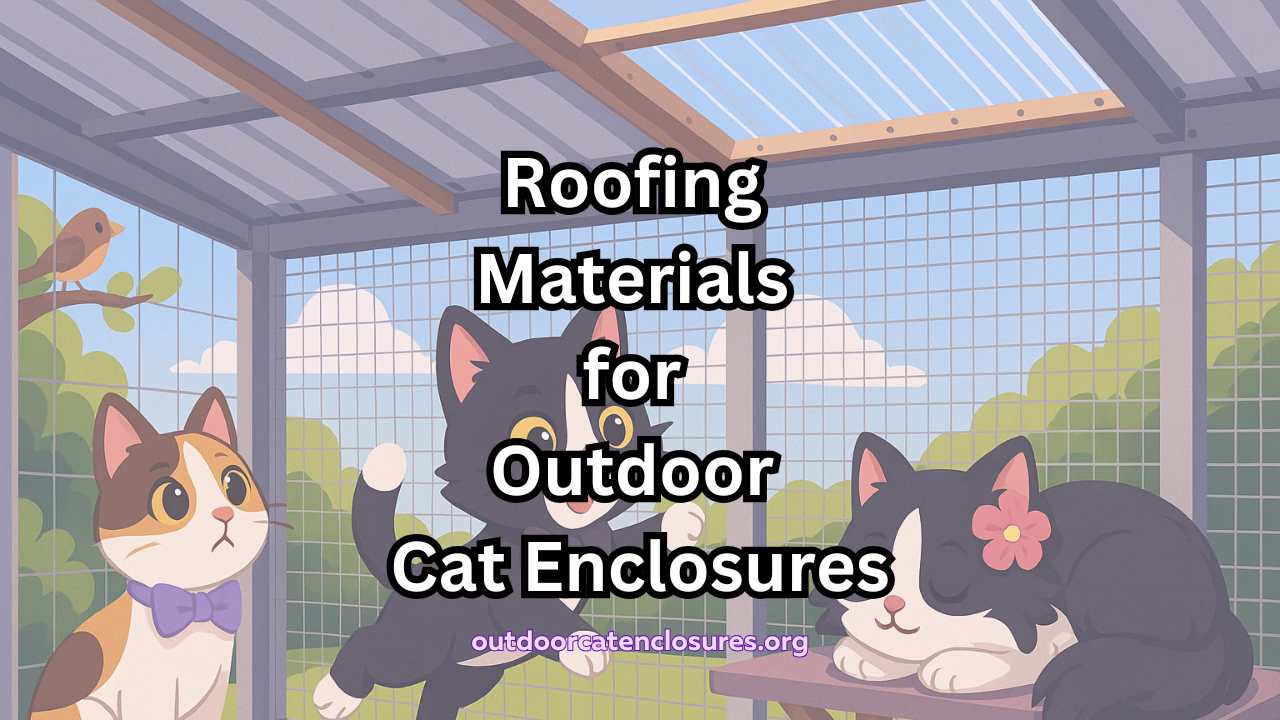When I built my first outdoor cat enclosure, I spent hours picking out the right mesh, platforms, and climbing spots — but barely gave the roof a second thought. I figured anything sturdy and waterproof would do.
I learned quickly that the roof does much more than keep out the rain. The right roofing materials for outdoor cat enclosures can change how warm, bright, and safe your cat feels inside all year long. The wrong one can make the enclosure too hot in summer, too dark in winter, or even unsafe in strong wind or snow.
If you’re designing or upgrading your catio, here’s what you should know before choosing between clear panels, solid roofs, or hybrid options.
Why the Roof Matters So Much
The roof is what protects your cat from weather — but it also shapes their entire experience in the enclosure. It controls sunlight, airflow, and how connected they feel to the outdoors.
In hot weather, a poor roof choice can trap heat, turning the space into an oven. In winter, it can let in cold drafts or snow. And because cats love lounging up high, many end up right under the roof — meaning it needs to feel safe, steady, and comfortable.
A well-chosen roof balances three things:
- Weather protection from rain, snow, and wind.
- Light and warmth, letting in enough sun without overheating the space.
- Durability, holding up to changing conditions without leaks or damage.
Common Roofing Materials for Cat Enclosures
Let’s look at the most common roofing materials cat parents use and how they perform through the seasons.
1. Clear Polycarbonate Panels
Clear polycarbonate panels are one of my personal favorites — and one of the best year-round options for most enclosures.
They’re lightweight, durable, and fully transparent, allowing plenty of sunlight while blocking harmful UV rays. That means your cat can bask in natural light even on chilly winter days.
Pros:
- Lets in natural sunlight for warmth and brightness.
- UV-resistant to protect cats from harsh rays.
- Durable and weatherproof — handles rain, snow, and wind.
- Keeps visibility clear so your cat can still enjoy outdoor views.
Cons:
- Can get hot in direct summer sun if the enclosure isn’t shaded.
- May require extra support or sealing in windy climates.
Best for: Cooler climates or year-round enclosures where sunlight and visibility are important.
If you live somewhere with hot summers, pair polycarbonate roofing with shaded areas or partial coverage to balance light and temperature.
2. Solid Metal or Shingle Roofing
Solid roofing, such as corrugated metal sheets or asphalt shingles, is great for heavy weather protection. It keeps out rain, snow, and sun completely — which can be helpful in regions with frequent storms or intense sunlight.
The downside is that it blocks natural light and can make the enclosure feel darker and less inviting. In summer, metal can also trap heat, making the space uncomfortable.
Pros:
- Excellent protection from rain, hail, and snow.
- Long-lasting and low maintenance.
- Ideal for areas with heavy precipitation.
Cons:
- Blocks sunlight and visibility.
- Can get very hot in summer and cold in winter.
- Louder during rain or hail, which can scare cats.
Best for: Wet, stormy regions or large outdoor setups that already get good sunlight elsewhere.
3. Hybrid Roof (Clear + Solid Panels)
For many cat parents, the best roofing material isn’t one type — it’s a combination. A hybrid roof blends clear panels with solid sections, giving cats a mix of warmth and shade.
For example, I use clear polycarbonate over part of my enclosure to let in light and solid panels over the rest for shelter. My cats can nap in the shade or stretch out in the sun depending on the day.
Pros:
- Offers the best balance of sunlight and protection.
- Lets you adjust coverage based on your climate.
- Great for multi-cat setups with different preferences.
Cons:
- Requires more planning and materials.
- Needs careful sealing where the two roof types meet.
Best for: Areas with mixed weather — hot summers, cold winters, and everything in between.
4. Waterproof Canvas or Fabric Covers
A waterproof canvas cover is a quick, affordable roofing solution — perfect for temporary or lightweight enclosures. It’s easy to install, adjustable, and can be removed in summer for more airflow.
However, it’s less durable than solid materials and may not hold up well in snow or strong wind. Cats who like to climb might also damage fabric roofs over time.
Pros:
- Budget-friendly and easy to set up.
- Removable for seasonal changes.
- Adds flexible shading.
Cons:
- Not suitable for snow or heavy rain.
- Can tear or wear out faster than hard materials.
- May require replacing every few seasons.
Best for: Mild climates or temporary enclosures that don’t face harsh weather.
Choosing the Right Roof for Your Climate
Your climate should guide your decision more than anything else. What works in Arizona won’t work in Maine.
- Cold and snowy areas: Choose solid or insulated polycarbonate roofing that resists snow and wind. Avoid fabric or mesh tops.
- Hot, sunny climates: Use a hybrid setup — partial shade and partial light. Add reflective materials or plant shade nearby.
- Rainy, humid areas: Go for solid roofing or tightly sealed clear panels with sloped angles to prevent leaks.
- Mild, balanced weather: Polycarbonate or canvas can work fine year-round with minimal maintenance.
If you’re unsure, start with a simple structure and expand later. It’s easier to add extra shade or cover than to tear out and rebuild the entire roof.
Seasonal Care Tips for Cat Enclosure Roofs
Once you’ve chosen your roofing material, take time to maintain it so it lasts through every season.
- Clean clear panels regularly to keep sunlight bright and reduce algae or dust buildup.
- Check seals and screws after storms to prevent leaks.
- Brush off snow before it gets heavy enough to bend or crack panels.
- Inspect canvas covers for tears or sagging.
- Provide shade in summer — trees, outdoor blinds, or tarps can help prevent overheating.
A few minutes of maintenance each month keeps your cat’s space bright, safe, and sturdy all year long.
Final Thoughts
The roof of your outdoor cat enclosure does more than protect from rain — it sets the tone for your cat’s entire experience outside. It controls light, warmth, and comfort through every season.
Choosing the right roofing materials for outdoor cat enclosures depends on your climate, budget, and your cat’s habits. Clear panels work best for sunlight and warmth, solid roofs for heavy weather, and hybrids for flexibility.
Whatever you choose, focus on creating a space that feels inviting, safe, and connected to the outdoors. Your cat will thank you with every peaceful nap and curious glance at the world beyond their walls.

